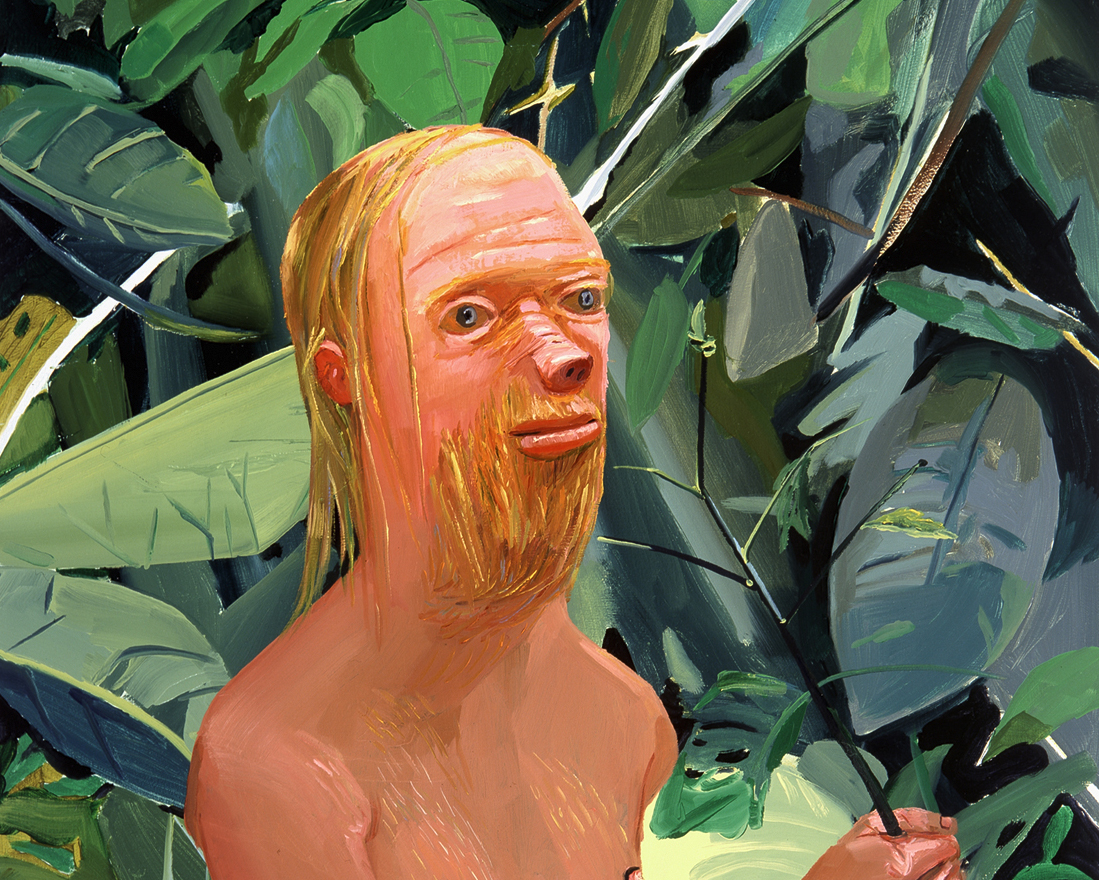【Sabik (2025)】
The Sabik (2025)Quotable David Salle
Arts & Culture

Dana Schutz, Frank as a Proboscis Monkey(detail), 2002, 36″ x 32″.
Recently, thanks to heavy wait times at the twenty-four-hour Genius Bar on Fifth Avenue, I found myself killing an evening at the Plaza with nothing to read but the galleys of a book of art criticism, How to See, by the painter David Salle. It turned out to be perfect company—witty, chatty, intimate, sharp. And slightly exotic (at least for this reader): you rarely see novelists write so knowingly, on a serious first-name basis, about each other’s work. Soon I was dog-earing and drawing lines in the margins next to favorite passages, as for example:
On recent paintings by Alex Katz:
Some of the color has the elegance and unexpectedness of Italian fashion design: teal blue with brown, black with blue and cream. You want to look at, wear, and eat them all at the same time.
On Dana Schutz:
She’s especially adept at handling a range of greens that aren’t found in nature but are often used to describe it, and she has a no-nonsense, unfussy way of building images that used to be called plasticity. The scale of her brushstrokes is almost always right—the marks suit what they describe, and gesture is most often harnessed to the painting’s internal architecture, not just surface decoration.
On Roy Lichtenstein:
It may look as though a painting, especially one as tidy as Roy’s, is the result of a set of decisions, but those decisions are in fact made at the end of a brush.
On Jeffrey Koons:
If abstract painting expresses the idea “You are what you do,” and pop art expresses the idea “You are what you like,” then Koons’s art says, “You are what other people like.”
On John Baldessari:
At least three generations of artists have had themselves photographed doing dumb stuff in banal settings. This is largely John’s fault. What the aesthetic embedded in John’s work accomplished was to give the everyday-Joe artist a way to embrace and lavish a little love on the everyday-Joe visual culture that is all around us, especially if one is stuck in the provinces and doesn’t really have access to the ethos or the rationale of a more highbrow style.
On Jack Goldstein’s films:
It’s like walking through dried leaves on a chilly fall day—you keep your hands in your pockets, kicking leaves into the gutter, all the while hoping someone will see and feel sorry for you. The self-consciousness of the act doesn’t necessarily diminish its poetry.
On André Derain:
Continuity is the dialogue a painter carries on with himself in the guise of his precursors. It’s what stays left after the novelty burns down.
On Francis Picabia (“c’est moi”):
When Picabia turned his hand to realism—basically a system in which volumetric form is defined by contrasts of light and shadow—he kept his penchant for outlining as a kind of graphic stimulation, and the mash-up of volume plus outline gives the paintings of the ’30s and ’40s a brazen, provocative feeling … The work is so undefended—it was exhilarating.
On Anish Kapoor’s Cloud Gate:
It’s a giant baby toy, something that would be suspended over a crib, like a silver teething ring (from Tiffany’s!) or baby’s rattle. People have compared it to a UFO, but that doesn’t strike me as right—it’s from beforethere were UFOs. Baby doesn’t know about UFOs yet—baby just wants to grab shiny bean.
On CalArts in the ’70s:
One guy asked for $3000—a lot of money at the time—so that he could take a television and a generation up to a remote mountaintop, where he planned to watch reruns of The Beverly Hillbillies, and then blast the TV screen with a twelve-gauge shotgun. We gave him $300 with the suggestion that he check into the worst fleabag hotel in downtown Los Angeles, and shoot out the television screen in his room with a BB gun. Sometimes less is more.
On boredom:
Boredom is what happens when the truth about something can’t be told.
David Salle’s paintings are in the permanent collections of the Museum of Modern Art, the Whitney Museum of American Art, the Guggenheim Museum, the Metropolitan Museum of Art, the National Gallery in Washington, D.C., the Los Angeles County Art Museum, Tate Modern, the National Galerie Berlin, and many others. He lives in New York City. How to See will be released by W. W. Norton in October.
Search
Categories
Latest Posts
How to Settle Down with Dystopia
2025-06-26 16:21Breastfeeding videos can now be monetized on YouTube — here's why
2025-06-26 15:43How Boygenius went from indie supergroup to internet darlings
2025-06-26 15:16Commissioning Misleading Core i9
2025-06-26 14:29Popular Posts
How to Squeeze the Most Out of Your iPhone's Battery
2025-06-26 16:25Lucky Girl Syndrome is TikTok's latest manifestation trend
2025-06-26 15:18Best deals of the day Jan. 23: 17
2025-06-26 15:06Today's Hurdle hints and answers for April 7, 2025
2025-06-26 13:55Featured Posts
Best Max streaming deal: Save 20% on annual subscriptions
2025-06-26 16:13Apple's Vision Pro might not launch until March 2024
2025-06-26 15:54Wordle today: The answer and hints for November 19
2025-06-26 14:29Best deals of the day Jan. 26: Dyson Supersonic hair dryer, 24
2025-06-26 14:28Then and Now: Almost 10 Years of Intel CPUs Compared
2025-06-26 14:11Popular Articles
Study trains Port Jackson sharks to respond to jazz music
2025-06-26 16:03Kathy Acker’s Blood and Guts in High School
2025-06-26 14:55Newsletter
Subscribe to our newsletter for the latest updates.
Comments (266)
Neon Information Network
13 Good Games You Can Play on Laptops and Budget PCs
2025-06-26 16:15Miracle Information Network
NYT's The Mini crossword answers for November 19
2025-06-26 16:02Opportunity Information Network
Does ChatGPT work for finding Black Friday deals? We tested it ourselves.
2025-06-26 14:36Habit Information Network
Another OpenAI twist: Microsoft hires Sam Altman as AI team lead
2025-06-26 14:34Opportunity Information Network
Reality Distortion Field: 10 Things Apple Won't Directly Say But We'll Infer About the iPhone X
2025-06-26 14:32